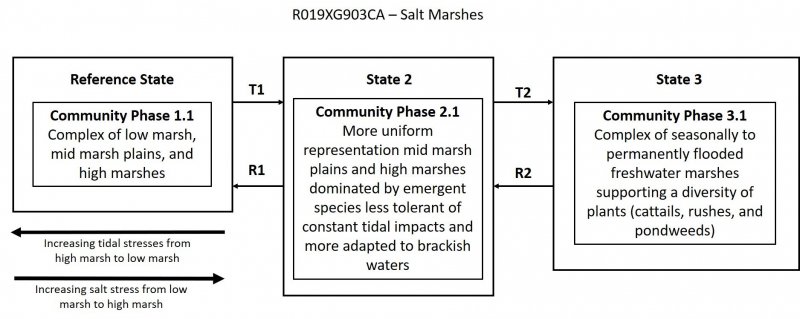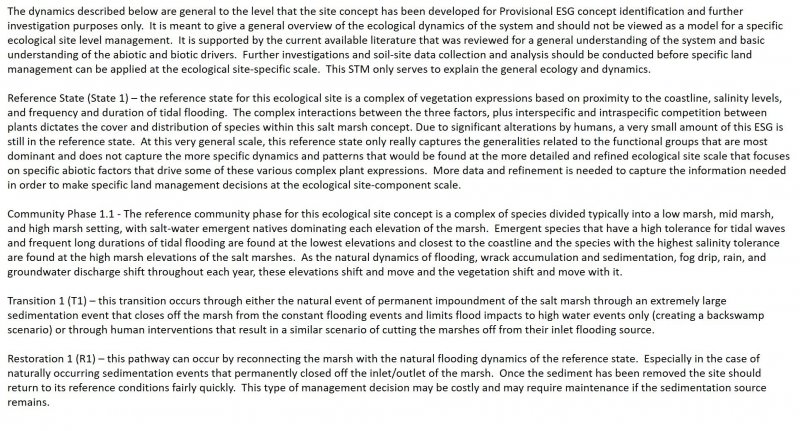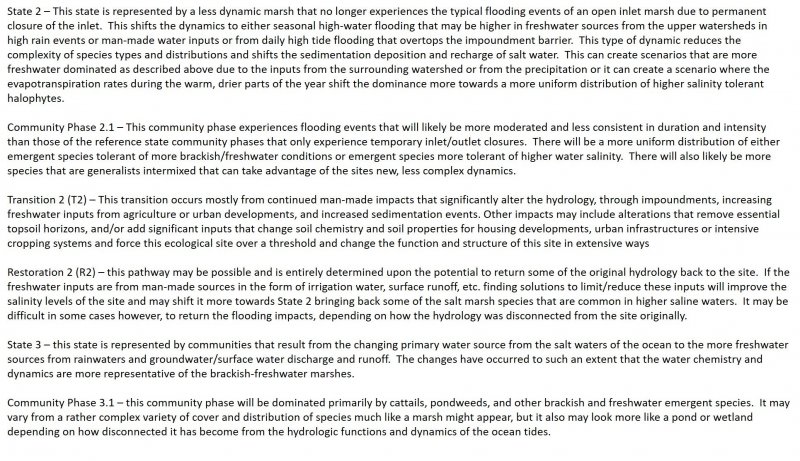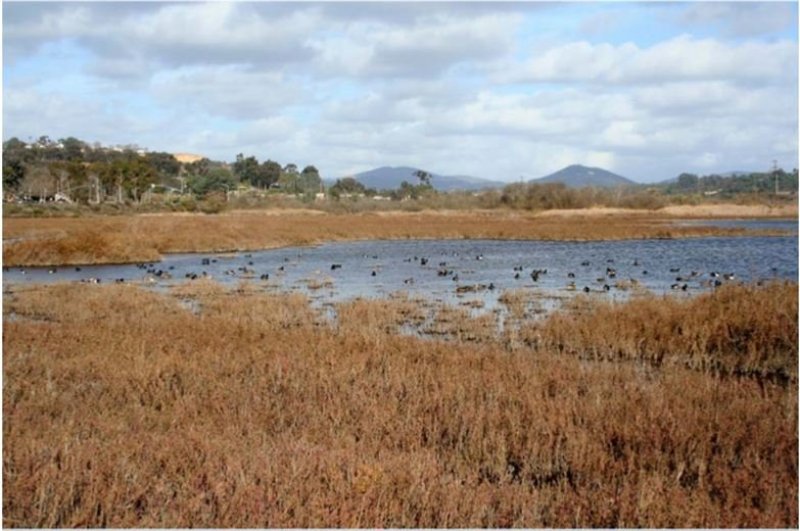Ecological site group R019XG903CA
Salt Marsh
Last updated: 07/05/2023
Accessed: 12/22/2025
Ecological site group description
Key Characteristics
- located in salt marshes
Provisional. A provisional ecological site description has undergone quality control and quality assurance review. It contains a working state and transition model and enough information to identify the ecological site.
Physiography
This ESG is associated with lakes, lagoons, sloughs and tidal marshes. Slopes range from 0 to 2% at elevations from sea level to 60 ft.
Climate
The average annual precipitation of the MLRA covers a diverse landscape of valleys and mountains and can range anywhere from 8 to 53 inches (215 to 1,354 millimeters), increasing with elevation. Most of the rainfall occurs as low- or moderate-intensity, Pacific frontal storms during winter. Rain can turn to snow at the higher elevations. A little snow may fall in winter, but it does not last. Summers are dry, but fog provides some moisture along the coast. The average annual temperature is 38 to 67 degrees F (3 to 19 degrees C). The freeze-free period averages 310 days in the valleys, 245 days in the mountains, and ranges from 125 to 365 days along the coast. It decreases in length with elevation. The longest freeze-free period occurs at the lower elevations along the western edge of the area.
High summer-fall humidity limited by salt. Average annual precipitation is between 25-35 inches, however fog commonly increases this amount by 10-15 inches.
Soil features
Soils associated with this ESG are highly varied in parent materials, organic content, and soil textures, however some of the common characteristics will include high salinity, mainly fine textured clays or silts (occasionally sand/clay), high seasonal water tables, and high pH. They range from somewhat poorly to very poorly drained and range from frequent to rare flooding and ponding.
Representative soils include Typic Xerorthents, Aquic Xerorthents, and Typic Fluvaquents.
Vegetation dynamics
This ESG covers the salt marshes of Southern California MLRA 19. These coastal salt marsh communities are only about 5%-10% of their historical range. They are easy to fill in for urban development or agriculture and are usually located in valuable land areas. They are also extremely sensitive to human activity.
This ESG includes both the inland salt marshes like the edges of the Salton Sea and Soda Lake in Carrizo, but for the most part are adjacent to the ocean. The inland areas have slightly different plants than the coastal sites, but are very similar.
Salt marshes are a mixture of halophytes (salt-loving) plants and wetland adapted plants (where the freshwater inlet lowers the salt to the point where less salt-tolerant plants can survive). Common species may include Frankenia sp., Distichlis spicata., Jaumea sp., Salicornia sp., and Suaeda sp. in the high salt areas, while Juncus spp, Myrica californica, Scirpus spp. and occasionally some Salix spp. live on the edges where the salt is not as highly concentrated.
Hydrology is the critical physical factor affecting vegetation in all wetlands, with the predominant hydrological influence in these marshes being tidal fluctuations. Tidal inundation directly affects two important factors for salt marsh plant distributions: soil oxygen status and salinity. At the low ends of the marsh, plants are typically stressed by excessive inundation and anaerobic conditions, whereas the critical factors for plant distributions in the upper marshes are primarily stressed by salinity, competition, or other biotic factors. Both salinity and soil aeration change with elevation and this change is a key factor in determining plant response and distribution. The critical components of tidal hydrology are depth, duration and frequency of flooding. Most often, these components are inferred from tidal elevations when determining vegetation expression, however maximum periods of inundation and exposure to inundation are more crucial than average inundation times.
Freshwater inputs are also a crucial factor dictating vegetation distributions and salt marsh hydrology. This is primarily driven by precipitation inputs and groundwater discharge. The salt marshes covered within this ecological site concept are a combination of both the heavily tidally-influenced marshes where freshwater inputs are rather minimal, and some where they are closer to river headwaters and freshwater groundwater sources that have more limited tidal influence and salinity is much lower. Many of the salt marshes that are further from the coast line and could either be drained or cut off from the coastal waters have become dominated by freshwater sources over time and tend to more closely resemble a freshwater marsh.
Hydrology drives sediment dynamics, which are what create and sustain these marshlands and dictate the elevations of each marsh community. In most cases the sediments accumulate gradually and are in balance with other processes that affect relative elevation, including sea level rise, subsidence, etc. As a result, these marshes tend to be relatively long-lived and stable. These salt marshes typically have the greatest mineral content in their sediments as well as high organic matter inputs, however many of the salt marshes that are close to the coast line in this ecological site concept are also heavily impacted by the dune sands that blow around and deposit these eolian sands within the marshes as well. Proximity to urban lands, timber harvesting and agriculture causes increased sedimentation into these marshes as well and can result in large shifts in vegetation expression due to the changing elevation levels within the marshes.
Soils are another key abiotic factor influencing the plant distributions within this salt marsh ESG. The soils are generally fine-textured, have poor drainage and slow decomposition rates, which leads to high rates of organic matter accumulation. There may be areas of salt marsh near the coast line that will have much coarser-textured soils that drain rather rapidly and have a different chemical composition, due to the eolian sand deposits. Microbial activity in these salt marsh soils also plays a huge role in the dynamics of this ecological site concept. These marsh soils, soil microbes and hydrology combine to create unique chemical conditions that directly impact vegetation response. As these fine-textured, highly organic soils are flooded, the available oxygen is rapidly depleted. The subsequent microbial demand for an alternative electron receptor other than oxygen during the organic matter decomposition process leads to a series of biogeochemical oxidation-reduction reactions in hydric soils. These low redox conditions lead to the formation of phytotoxic compounds, such as sulfides and denitrification requiring the vegetation that is found in this type of environment to be specially adapted to these types of conditions.
Soil salinity is also a critical factor to the soils of this ESG, and is driven primarily through water salinity and evaporation rates. In areas where tidal flushing is frequent, the salinity of soil pore water will be relatively similar to the salinity of the overlying water. However, in the high marsh areas that are not regularly flushed by new waters, the soil salinity is actually much higher than that of the flooding waters that still impact the site, due to evapotranspiration. This process is rather muted in these salt marshes, thanks to the more moderate climates where this ecological site concept is found, however this process will still occur to some degree thanks to the months that are warmer and have limited fog coverage. Spatial and temporal variability of soil salinities are large enough to affect the vegetation patterns of this ecological site concept with relation to elevation and seed germination. There are several species that show significant germination success in high salinity situations, but others that require reductions in salinity during seasons of freshwater influence or recharge in order to get established and withstand the higher saline conditions. Significant reductions in salinity however, can allow the invasion of exotic species that capitalize on the lower salinities and then outcompete for resources once established.
There are few natural disturbances to these salt marshes, outside of the timing, frequency and duration of flooding that regulates the site and keeps the natural dynamics in balance with vegetation adaptability and response. These coastal salt marshes are generally open to the ocean, however this opening will naturally experience events of sedimentation that temporarily close off the marsh from the ocean and create a spit or sandbar between the open ocean and marshes. This will change the dynamics to some degree, but not significantly outside the natural dynamics and stability of the salt marsh. Wrack accumulation (seaweed deposition) and large sedimentation events can also have some impact locally within the areas of the marsh that are in closer proximity to the coast line. Both may bury some plants that are not well adapted to burial, leaving openings for other species that can withstand burial to take those open niche spaces.
Man-made disturbances, such as urban development, timber harvesting and agricultural practices can have significant impacts on the dynamics and vegetative responses leading to state changes that are difficult to reverse without outside inputs in time, labor and money. With many of these outside disturbances large amounts of sediment are added to the system, altering the elevations within the marsh and creating new hydrology-soil-chemical reactions and drainage scenarios that change the ability for certain species that are native to the salt marsh to survive and outcompete other non-native or freshwater native species for niche space. The other significant disturbances that can occur in this system is permanent impoundments that close off the marshes to the tidal influences and salt-water recharge that regulates the system, allowing freshwater from precipitation, fog drip, and groundwater discharge to have a greater influence in the water chemistry. Irrigation from sprinklers in urban environments and from agricultural practices can also change the amounts of freshwater inputs that also change the water chemistry and impact vegetation expression and site dynamics.
Information from Barbour et al, 2007. Terrestrial Vegetation of California and Las Pilitas Nursery website (www.laspilitas.com)
Major Land Resource Area
MLRA 019X
Southern California Coastal Plains and Mountains
Subclasses
Correlated Map Unit Components
23481794, 23477314, 22666867, 22666864, 22670930, 22670929, 22670928, 22671136, 22671137, 22671223, 22671224
Stage
Provisional
Contributors
Curtis Talbot
Click on box and path labels to scroll to the respective text.



